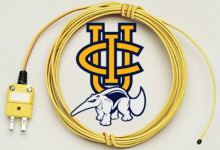E-Thermosensor
Background
A thermocouple is an electrical device used to detect the temperature changing. Nowadays, thermocouple, as a kind of thermal sensor, is being used in many fields, for example, hospital, vehicle engines probes, and sensors. With the trend in demand for increased performance and reliability.
We are focusing on how the time response will change regarding the change in the size of the thermocouple in microscale. If the time response is reduced, the efficiency of the temperature sensor system will increase, which would benefit in many fields.
Goal and Objectives
Our goal for this project is decreasing the time response for an accurate reading from 0.06s to 0.03s by reducing the size of thermocouples. Having a faster response, thermocouples can be more efficient in measuring temperature changes in industrial, medical and daily aspects. Then apply the wireless device to make it into a product.
Fall 2018
Researching on thermocouples; purchasing most of the equipment that we may need; using ice bath & boiling water to calibrate the thermocouples.
Winter 2019
Trim the thermocouple tips in to different lengths, measuring the time responses for each thermocouple (in the same temperature range); break down the thermocouple tip and research about different materials.
Spring 2019
Test different type of thermocouple and compare the measured data with our assumption. Build a thermocouple by our own and choose proper material. Using wireless device to make the thermocouple into products.
Innovation & Current work
Fall quarter:
We create an Arduino system with AD620 amplifier powered by a 12V battery that can amplify and measure the voltage change of type K thermocouple under different temperatures. We will use this system to test the time response for different materials and sizes of the thermocouple, then find a way to reduce the time response (for example, cut down the size, add graphite coding, etc.)
Winter quarter:
We reconnected the circuit using jump wires instead of breadboard to cancel the noise. We tested the circuit by placing the thermocouples into the ice water, and tried cut tips in half length, but with no improve in time response. Therefore, we switched back to the original length tips, but tightened the cord. We managed to shorten the time response from 0.16s to 0.08s, but the noise was a lot more than before.
We replaced the purchased type K thermocouple with a shorter thermocouple made by us. The new thermocouple is made of Nickel-Chromium wire and Nickel-Alumel wire. We shortened the length to about 300mm and plug the wire directly in the amplifier. Both wires were twisted together to form two short tips. The delay time in Arduino between two sample data was lowered from 10ms to 0.8ms (The minimum delay time for arduino is 0.69ms). The new setup can reach 8ms time response in the experiment for the low T variation (ice water), which completely fulfilled the expected goal 0.03s from last quarter.
Contacts
Faculty Advisor: Professor Yun Wang
Email address: yunw@uci.edu
Student Contact: Bowen Chen
Email address: bowenc6@uci.edu



